"Estamos en la terraza"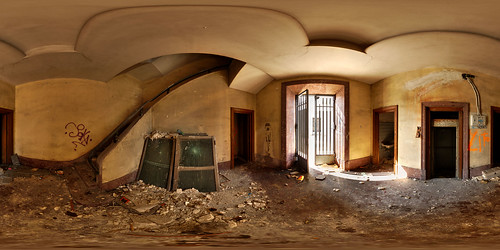
Image by Daniel Dionne
Base del Arco de la Victoria de Moncloa, Madrid. (English down below)
Vista interactiva <-- PINCHA AQUÍ, así es como está pensado que se vea esta foto (puede tardar un poco en cargar)
Aun viviendo tan cerca, nunca me había planteado acercarme al Arco de la Victoria de Moncloa. Siempre lo había visto (y fotografiado) desde lejos, dada su situación tan innacesible. Esta mañana, con idea de hacer una foto panorámica justo desde debajo del arco, decidí acercarme con mi padre. No me esperaba verlo tan sucio y descuidado. Había restos de basura y grafitis por todas partes. Y lo que sí que no me esperaba era encontrar la reja de acceso abierta.
Hace un par de semanas vi a unas personas entrar por esa misma puerta, y en su momento pensé que serían amigos de alguien que tendría acceso. Hoy sin embargo me he dado cuenta de que debía llevar abierto mucho tiempo, dado el estado en que se encuentra el monumento.
Mi padre intentó subir las escaleras, pero tras el primer tramo se encontró en la oscuridad más absoluta, y tuvo que volver a bajar.
Decidimos volver por la tarde con una linterna, para seguir explorando, pero cuando llegamos vimos que la reja había sido cerrada con un candado. Quizá fue casualidad que la encontráramos abierta.
La foto está compuesta a partir de 55 fotos diferentes, tomadas con un gran angular de 10mm: 18 encuadres por 3 exposiciones cada uno, más una foto del suelo. Después se han unido todas las fotos con Hugin, comprimiendo el rango luminoso para que las zonas oscuras y claras se vean mejor (lo que comúnmente se llama HDR).
Más información sobre el Arco de la Victoria.
Base of the Arco de la Victoria, in Moncloa, Madrid.
Interactive view <-- CLICK HERE, this is how this picture is meant to be seen (it might take a moment to load)
Living so close to it, I never thought of getting close to the Arco de la Victoria in Moncloa. I've always seen it (and photographed it) from far away, since it's very innacesible. This morning, with the idea of taking a panoramic picture from under the arch, I decided to go with my dad. I wasn't expecting it to be so dirty and abandoned. There was trash and graffiti everywhere. What I really wasn't expecting was the door to the monument to be open.
A couple of weeks ago I saw some people get in, and I thought that maybe they were friends with someone who had access to the arch. Today I realised that it must've been open for a long time, which explains why it is so dirty.
My dad tried to climb the stairs, but he found nothing but darkness on the second floor, so he had to get back down.
We decided to go in the afternoon with a flashlight, to explore a little more, but when we got there we saw that the door had been closed and locked. Maybe it was just a coincidence that we found the door open.
The photo was made from 55 different pictures, taken with a 10mm wide angle lens: 18 frames times 3 exposures each, plus a photo of the ground. All the pictures where stitched together using Hugin, compressing the light spectrum so that dark and bright areas look better (HDR technique).
The title of the picture says "We are on the terrace", which is painted on the stairs.
More information (in Spanish) about the Arco de la Victoria.
Divided by zero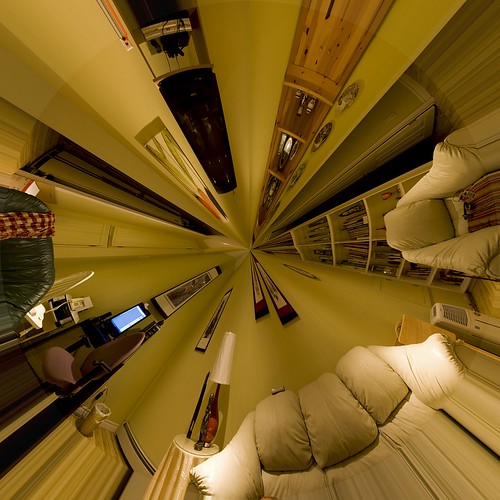
Image by Zach Bonnell
Well, my sleep schedule is quite off now, I woke up at 11 tonight. We got my pictures all set up and framed now for the craft fair next weekend.
I tried to do a planet of my basement, but it looks like I divided by zero.
APS panoramic framing, the vertical way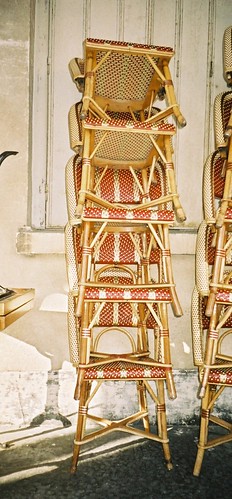
Image by busy.pochi
My first ever APS shot.
Some café terrasse chairs piled up in the morning place des Vosges.
There are many reasons why the APS was doomed to fail.
And two reasons why it deserved to succeed: here is one of them, the framing choice (actually the "printing intention choice", since the whole film is always exposed anyway).(*)
I The nice thing is that you actually switch between 3 framing, and most importantly *see* the result. I can't understand why this is not available on ALL and EVERY digital camera, this is sooooo easy and cheap to do by software (at least on the LCD). The only thing missing is a square framing. It is very different to think a framing and being actually able to see it when on the field.
About 80% of my pictures are verticaly framed. I don't know why, though a friend told me "sure, this is the Japanese woodprint fornat isn't it"?". I'll have to think about that. Back to APS: this panoramic, 3x1 format is clearly intended for landscapes. As for me, I immediately took a "malin plaisir" (wicked pleasure?) to use it verticaly. I felt at ease instantly with it. Thank you thank you thank you APS for this. No cropping needed, but real, from the field, narrow view.
*: actually, my camera/lab shop explained me this framing choice was one of the reason for APS failure, because people always got confused with it, and told "hey, this is not what I wanted!"
Fujifilm 265 ix Zoom + Fuji Nexia A200
scan from the lab
Holga 1st panoramic experiment shot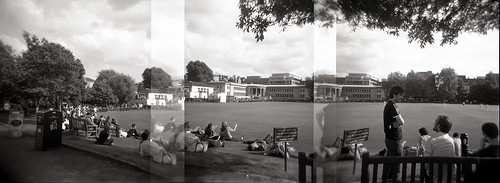
Image by pallotron
View bigger in black.
Here is a first attempt of shooting panoramic photographs with the Holga.
Pictures have been taken at the Trinity College cricket ground in Dublin.
It's total guess work. The game is overlapping frames and taking shots from the left to the right...
The trick is not to wind roll normally to the next frame but take note of the position of the tail of the arrow atop the advance knob remember to wind the roll until the head of the arrow has reached to position of the tail (you can use your thumb for this)...
It is important also to keep the camera at the same height when rotating...
To be my first attempt i'm actually happy with it...
Ilford HP5+ developed in Studional 1+30 for 8'
Kodak Stretch 35 Disposable 35mm Camera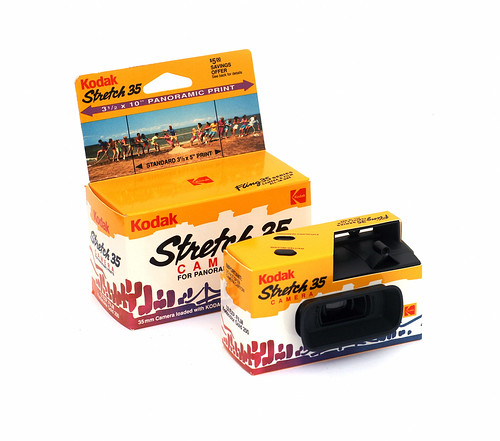
Image by Capt Kodak
Manufactured in 1990 by the Eastman Kodak Company. Part of the “Fling 35 Series Camera & Film All-In-One” group of cameras, the Stretch 35 was loaded with 12 exposures of 200 ISO Kodacolor Gold film. Designed to produce panoramic pictures, it took a narrow image in the center of a standard 35mm frame and was designed to be printed as a 3-1/5 x 10 inch print (the photofinisher just had to know and print the negative as if they were making an 8 x 10). If featured a wide peep sight for framing the picture.
Are disposable cameras collectable? First, they are a phenomena of the late 20th / early 21st century. The more proper term “Single Use Camera” and they brought photography to the truly occasional photographer. They became unique for the odd features and varieties. And their use is now engrained in our culture—who doesn’t put out several at their wedding reception for the guests to snap pictures of each other! And, by their specific nature, they are destroyed. So common today that they hang at every grocery checkout line, but one day they’ll be rare. You decide…
No comments:
Post a Comment